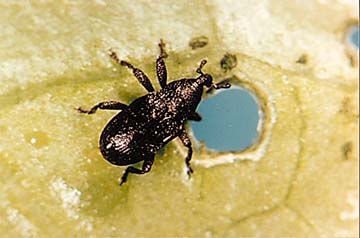


State sics
new bug onto
prolific weed
300 weevils, the last of
By Leila Fujimori
an insect assault team,
are released in Makiki
Star-BulletinThe state Department of Agriculture is pinning its hopes on a leaf-mining weevil, no bigger than a medium-sized ant, to knock out aggressive ivy gourd.
The black weevils "look wimpy, tiny and puny -- they don't look like they'll do anything," said Kenneth Teramoto, chief of the Biological Control Section of the Agriculture Department. "But their population is going to zoom up."
Adult insects and the larvae feed on the leaves.
Scientists released 300 African beetles in Makiki Heights yesterday to control ivy gourd, a noxious weed blanketing everything from trees and utility poles to abandoned cars on Oahu and the Big Island. It also weakens and kills other plants by cutting off sunlight.
Once the weevil is established, it will bring the ivy gourd to a lower level, but not completely wipe it out, Teramoto explained.
The lowland vine, Coccinia grandis, is recognizable by its pickle-sized cucumber-like fruit that turns scarlet when ripe, its five-point leaves and white star-shaped flowers. It is a member of the cucumber family and has above and underground tubers. Its worst infestations on Oahu are in Waimanalo and parts of Haleiwa. On the Big Island, Kailua-Kona and Napoopoo have been hit.
Extensive testing was done to ensure that the weevil, quarantined from 1992, does not attack other plants including natives. It lays its eggs exclusively on the ivy gourd and does not pose a threat to a related native plant, officials said.
Entomologists used 20 to 30 plants representative of plant families in their testing.
"I'm confident that these three insects will not attack any plant except ivy gourd," stated Teramoto.
The weevil is the third member of a team of insects released by the Agriculture Department, each designed to attack different parts of the plant. On Aug. 27, the ivy gourd gall weevil was released in Waimanalo. And in 1996, a moth, the ivy gourd vine borer, was released in infested areas of Oahu.
Entomogists say that as the ivy gourd diminishes, these insects will, in turn, decrease in number.
In 1992, five insects were discovered and brought from Kenya to Hawaii by the Agriculture Department's exploratory entomologist. Two were found unsuitable for Hawaii. In East Africa, the ivy gourd grows as a native but is not a pest because of its natural enemies.
The ivy gourd was first discovered in the Punchbowl area on Oahu in 1968. Bulbuls and other birds fed on the fruit and spread its seeds.
Teramoto suspects someone brought the ornamental plant home from a trip from southern Asia, where it also grows. Or possibly, it was brought in as a food plant -- its fruit and young shoots are edible.
Minor infestations on Maui and Kauai were eradicated by mechanical and chemical means.
Residents with an ivy gourd problem can use herbicides such as Roundup and Brush-B-Gone as well as cutting the above ground portions and digging up the tuberous roots.
Teramoto said it would be impossible to root out all the ivy gourd growing in the wild in gulches and ravines.
"That's the value of biocontrol," he said. "It's self-perpetuating once it's established."